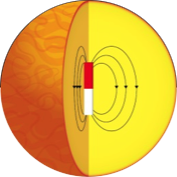Victor Silva Aguirre co-authors yet another Nature paper
Strong magnetic fields are frozen into most stars, concludes a.o. astronomers Dennis Stello, Victor Silva Aguirre and Tim Bedding from SAC in Nature paper published on 4. January 2016.

Ordinary stars are very different inside than previously thought. Astronomers from a.o. Stellar Astrophysics Centre at Aarhus University discover strong magnetic fields in most stars to everyone's surprise. Our knowledge of the Sun and other typical stars will have to be revised.
Denmark is again on the forefront of astrophysics, thanks to astronomers a. o. from Aarhus University. A new breakthrough might lead to a better understanding of the Sun and sunspots. The new results are published in the renowned science journal Nature on 4. January 2016.
An international team of astronomers with former student and co-worker at Aarhus University, associate professor Dennis Stello (now at University of Sydney and a member of Stellar Astrophysics Centre, based at Aarhus University) has used a newly developed technique to detect magnetic fields inside almost 1000 stars observed with the NASA Kepler space telescope.
"This is an extremely interesting and totally unexpected result", Dennis Stello explains. "Previously we only knew of a very small number of stars with strong magnetic fields in their interiors. In our theoretical stellar models we have been missing magnetic fields as a fundamental ingredient. Magnetism has previously been considered insignificant for our general understanding of how most stars develop over time. These new results suggest that close to 60% of stars have even very strong magnetic fields inside. This means that we will have to revise our assumptions concerning both the abundance and influence of magnetic fields".
Team member Victor Silva Aguirre of Aarhus University explains: "By using a new technique in asteroseismology; the study of the oscillations of stars, we can now see through the stellar surfaces directly into the interiors of the stars, and we detect the presence of what we think are very strong magnetic fields in the central parts of the stars, where nuclear burning occurs. The central part is the engine of the stars, and strong magnetic fields probably play an important role in the evolution of the stars. The fields are able to influence the physical processes taking place in the very centres".
Most stars including the Sun show oscillations caused by so called standing waves inside of the stars. "One may compare the stellar interiors to a huge bell", Victor Silva Aguirre explains. "And similarly to a bell or another type of musical instrument, the sounds generated by the star will tell us about its physical properties such as size, temperature and composition".
The research team used data from NASA's space mission Kepler measuring ultra small variations in the light output from several thousand stars. The variations are caused by this ringing in the stellar interiors. Dennis Stello describes: "We found that certain vibrational frequencies were missing in 60% of the stars, because of magnetic damping deep inside of these stars. It resembles a trumpet having a totally different sound because someone has forgotten a piece of cleaning cloth inside it!".
Magnetic damping in stellar oscillation patterns has previously been observed in fewer than 40 stars, but a new analysisof the full set of data from the Kepler mission revealed that this effect occurs very often in Sun-like stars, and specifically in stars slightly more heavy than the Sun.
"It is simply fantastic! Now we can actually test our models for how magnetic fields are produced inside the stars", Victor Silva Aguirre says. "Previously we had to do with advanced computer calculations for testing what we call magnet dynamo models. Without observations of real stars, we have not been able to verify the models. Personally I am looking very much forward to see how well the models comply with our new observations. Potentially this will open up for at better general understanding also of the magnetic dynamo controlling the 11 year cycle of sunspots on our own Sun. There is suspicion that this cycle effects climate here on Earth, making our new discoveries very relevant also in other fields of science".
Read the full article here.
For further information, please contact:
Associate Professor Dennis Stello
Sydney Institute for Astronomy, University of Sydney/Stellar Astrophysics Centre, Aarhus University
cell phone +61 4242 34550
or
Assistant Professor Victor Silva Aguirre
Stellar Astrophysics Centre, Aarhus University
e-mail victor@phys.au.dk
